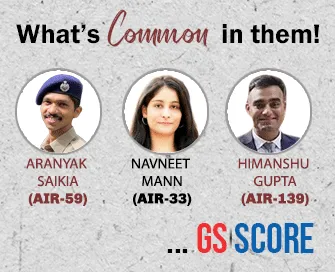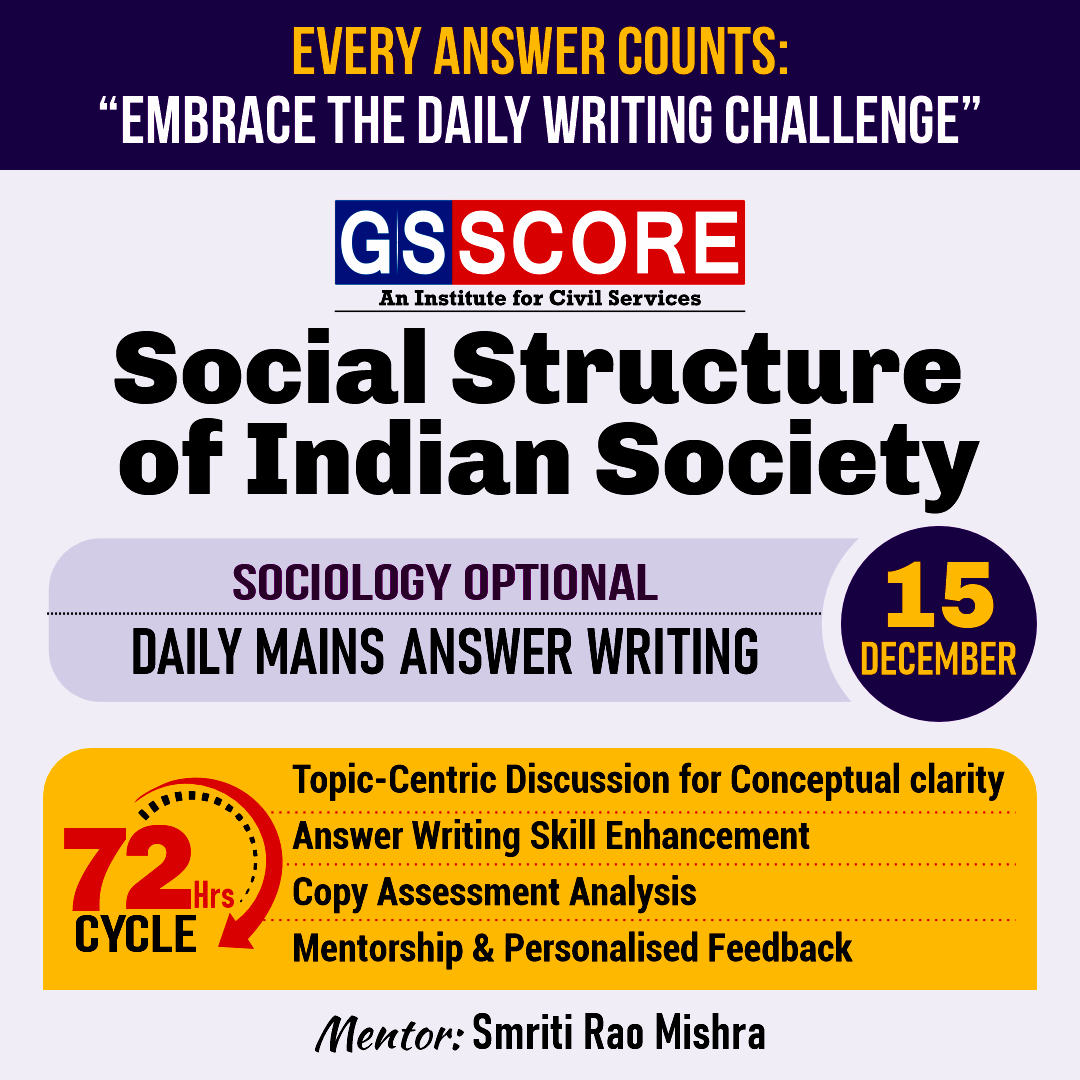


Instruction:
- There will be 2 questions carrying the First Question is-10 marks Write your answers in 150 words and the Second Question is-15 marks Write your answers in 250 words.
- Any page left blank in the answer-book must be crossed out clearly.
- Evaluated Copy will be re-uploaded on the same thread after 2 days of uploading the copy.
- Discussion of the question and one to one answer improvement session of evaluated copies will be conducted through Google Meet with concerned faculty. You will be informed via mail or SMS for the discussion.
Question #1. Theoretical paradigms used to study the Indian society can be better understood through the distinction between book view and field view. Comment. 10 marks (150 words)
Question #2. Using Yogendra Singh’s theory on Modernization, reflect upon the changing contours of Indian society. 15 marks (250 words)
(Examiner will pay special attention to the candidate's grasp of his/her material, its relevance to the subject chosen, and to his/ her ability to think constructively and to present his/her ideas concisely, logically and effectively).
STEPS & INSTRUCTIONS for uploading the answers
Step 1 - The Question for the day is provided below these instructions. It will be available at 7:00 AM.
Step 2 - Uploading of Answers : Write the answer in A4 Sheet leaving proper margins for comments and feedback and upload the PDF in MY ACCOUNT section. Click on the option of SUBMIT COPY to upload the PDF.
Step 3 - Deadline for Uploading Answers: The students shall upload their answers by 7:00 PM in the evening same day. The first 50 copies will be evaluated.
Step 4 - Feedback : Mentors will give their feedback for the answers uploaded. For more personalised feedback, join our telegram channel by clicking on the link https://t.me/mains_answer_writing_cse . A one-to-one session will be conducted with the faculty after copy evaluation in 72 Hrs.
Model Answer
Question #1. Theoretical paradigms used to study the Indian society can be better understood through the distinction between book view and field view. Comment. 10 marks (150 words)
Indian society is known for its diversity and pluralism. To study Indian society “one-size-fits-all approach" won’t work. Hence there are multiple approaches and methodologies. The book view and the field view are such two approaches that make the core difference between how sociologists with these two approaches would perceive and subsequently write about society.
Difference between book view and Field view:
- Book view
The book view in Indian sociology is one that would make a sociologist develop a picture of the Indian society which would very much be in line with the way the Hindu scriptures and, partly, the historical records, describe it. In other words, text view or book view refers to the study of Indian society by interpretation of ancient texts such as Vedas, Puranas, Manusmriti, Ramayana, Mahabharata, etc. This text-based approach is also known as Indology.
In Indian sociology, G.S. Ghurye and many other scholars have extensively contributed to the Indological studies by interpreting ancient Indian texts.
- Ghurye demonstrated through the textual evidence, that the caste system is rooted in the concept of purity and pollution, and provides an integrative framework in the kinship structure. With his 5 fold characterization of the Caste system, he was able to provide structure to this phenomenon unique to the Indian subcontinent.
- Field view
According to Beteille, “Field-view or the view from the field refers to an orientation to the experiences of people, with their inner tensions and contradictions which one seeks to understand and interpret.”
M.N. Srinivas has made a great contribution to the post independent Indian intellectual landscape by emphasizing on fieldwork. He conducted an extensive field study among Coorgs in South India and revealed a unique practice there under the caste system which he termed as sanskritization. Similarly he gave a concept of Dominant caste from another field study.
Contradictions in both the views:
Writers like James Mill, Charles Metcalfe, viewed Indian villages as little republics and self-sufficient. Their studies were largely based on the book view of Indian society.However Indian sociologists were quick to point out the inherent bias and uni-dimensional analysis of the Indian society as espoused by western thinkers, historians, administrators. Therefore, the Book view generated by Indian sociologists showed a remarked difference.
In addition to this, both the views have their own drawbacks as well such as field view may have a risk of sociologist’s biases and preconceived notions on the other hand book view, according to some, would produce a colorized view of the Indian society.
Blend of the approaches:
With all that in mind, it is better to conduct the study in society, having elements of both the approaches for example Prof.Dumezill’s historical analysis of Varna complements Hocart’s work on caste, largely based on direct observation. Hence, there isn’t any supremacy in the methodologies, rather a confluence of views is more likely to produce a comprehensive analysis.
The book view and field view, both contributed to the emergence of Sociology as a distinct discipline in the Indian context.
Question #2. Using Yogendra Singh’s theory on Modernization, reflect upon the changing contours of Indian society. 15 marks (250 words)
Modernization refers to a process of social change where by less developed societies acquire the characteristics commonly associated with more developed societies. Though, social change occurred in traditional India, it was essentially pre-modern in nature. One traditional institution was just replaced by another and no basic structural change took place in social system and culture.
Historically, modernization in India started from the establishment of the British rule and had continued even after the independence. The nature and direction of modernization during these two phases have been different. However, it is through theorisation that the changing contours of Indian society have been better understood
Yogendra Singh in his ‘Essays on Modernization in India’ analyzed the varied and complex processes involved in the modernization process in India under the British rule. His idea of social change and modernization is a combination of cultural as well as structural changes.
Firstly, he locates the sources of social change as endogenous/orthogenetic or exogenous/heterogenetic. Orthogenetic sources of cultural change include processes like Sanskritisation, cultural renaissance, etc. whereas migration, population change, royal succession, etc. are the orthogenetic source of change at the structural level.
The heterogenetic sources of social change include exogenous sources like the Islamic influence in the medieval period and Western influence in the modern period.
The contact with the West brought about far reaching changes in social structure and cultural institutions. Changes were witnessed in almost all-important areas of life.
The British administration introduced new arrangements in legal, agrarian, educational and administrative domains.
For example, the bureaucratic system of administration and judiciary introduced by them were based on modern rational norms, which replaced the traditional Indian legal norms, based on the principle of hierarchy and ascription.
At the cultural level, Modernization of tradition took place in the form of infusion of modern values of rationality, scientific outlook, modern education, urbanization, struggle against social evils and amelioration of caste system.
The colonial phase of modernization created wide networks of structure and culture which were modern and had an all India appeal.
It was not integrated with the micro-structures of Indian society, such as family, caste and village community. At these levels, the British by and large followed a policy of least interference, especially after the rebellion of 1857. For a long time caste and ethnic factors were given recognition in recruitment of officers to army and middle and lower ranks of bureaucracy.
Post-independence, the political system has assumed a new shape after adoption of the parliamentary form of government based on adult franchise. Democratic political structure has effectively led to increasing political consciousness among the people. The process of politicization has further, been accelerated through the Panchayat Raj institutions.
The foundations of traditional family structure have come under influence of legal reforms in marriage and inheritance. The laws like Hindu Marriage Act, 1955 introduced equalitarian norms in family leading to raised status of women.
Similarly, caste has assumed new functional roles. It has acquired an associational character. Increasing role of caste in politics points towards this trend.
However, it is important to note the fact that modernization in India has not been uniformly progressive movement. Two crucial issues may be pointed out in this regard :
First, in the process of modernization several traditional institutions and activities have been reinforced. For example, religious preachers are using modern media to spread their ideas. Now, there are television channels in India exclusively developed to religious preaching. Religious revivalism, communalism, caste conflicts, etc. have increased. These dysfunctional changes are not the champions of modernity
Second, inconsistencies are visible in patterns of modernization. Though structural change is witnessed in family, joint family loyalties and norms still prevail. Democratic participation is increasing despite of increasing caste conflicts.
After independence, the modernization process has undergone some fundamental changes. Every domain of social system is under the active influence of modernizing process. Modernization has, now, become an integral part of the developmental strategy.

